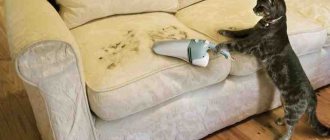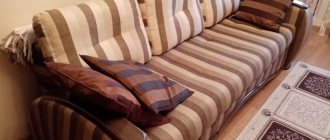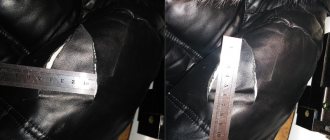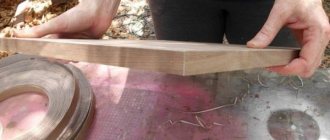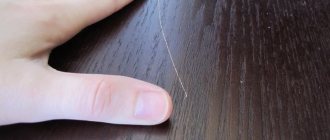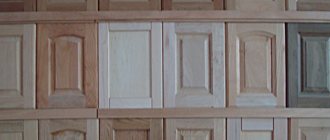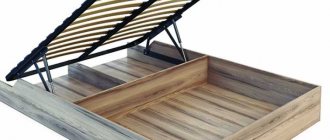0
66249
Leather upholstery for furniture is considered one of the best materials. It combines strength and presentable appearance. But during use, stains and scratches will still appear. It is possible to carry out minor repairs to leather furniture on your own, although much depends on the nature of the damage. If the contamination or defect is not eliminated in time, the furniture will lose the value and richness of the color of the upholstery. With scratches and cracks, the situation is even worse - if repairs are not started in time, the crack can grow to such a size that it will be easier to buy a new sofa.
What is liquid skin
The substance that repairs damage to the leather covering is paint. It has a very high adhesive ability and easily penetrates the surface. After drying, a single integral coating is formed with the original material, so it returns to its previous appearance: it is elastic, durable to the touch. If we are talking about the restoration of a natural coating, then delamination with the surface is completely excluded. This guarantee does not apply to leatherette, leatherette and other artificial coverings.
The skin restorer is available in sets of 7 colors. One jar contains about 20 grams of paint, which is enough to repair 100 square centimeters if applied in a layer of 0.2 mm. Consumption depends on the size and depth of the damage: in some places you can limit yourself to applying one layer, in others you will have to cover it several times. On average, the entire set is enough to restore from 30 to 100 items.
Compound
The paint, which seamlessly seals holes in leather, is a heavy-duty polymer made from water and alcohol. In addition, liquid leather contains rubber resin, emulsifiers, and dyes. In appearance, the liquid resembles gouache, and after application it is completely absorbed into the surface and forms a single coating that does not peel off and is in no way inferior to natural in strength.
How to use
Repairing leather products begins with cleaning: it is necessary to remove all dirt and degrease the surface, and after that the color is selected. The color palette included in the set will help you create any desired shade. How to use liquid skin? It depends on the nature of the damage:
- Scuffs. They need to be painted over with a thin layer of paint, then leveled, lightly pressing with a dry sponge (this gives the new coating the same relief), and left to dry. Repeat if necessary.
- Cuts and cracks. To make them disappear, tightly connect the edges and apply the composition with a brush, then level. Leave it to dry a little and repeat the procedure.
- Deep cuts. If possible, it is better to turn the product inside out, then join the edges. You will have to fill the space with foam rubber on the furniture. Apply paint to the front side in small portions, using a brush and remembering to level the surface and blot it with a sponge. You can repeat the procedure several times.
It is important to remember that the substance begins to set very quickly, after 10-30 minutes, so the jars must be closed immediately. The paint can dry completely within 2-3 hours of being in an open container. After completion of the work, the composition is absolutely safe. During repairs, you must try to limit contact with the skin and especially with the eyes. If the dried coating needs to be removed from the surface, wipe the area with alcohol and everything will come off.
What is “liquid skin”? The most used types from manufacturers
With the help of modern technologies, you can carry out minor repairs to leather products right at home.
“Liquid skin” is a polymer mixture based on alcohol and water. The sticky adhesive base and rubber resin included in the product when repairing leather products help the mixture to firmly adhere to the top layer, forming an elastic consistency.
Liquid leather is a paint that imperceptibly seals holes in the skin; it is a heavy-duty polymer based on water and alcohol.
After hardening, the restored area is practically no different from the general surface. In addition, “liquid leather” retains the properties inherent in natural material.
“Liquid skin” is very easily absorbed into the material, and within a day a scratch or any other damage will become invisible
Another component of this unique product is dye. Today, manufacturers offer a wide range of colors, which allows you to choose the desired shade to match the color of the furniture. When working with complex colors, mixtures can be mixed to achieve the desired result.
Liquid leather is produced in the form of sets with jars of different colors
The main direction of use of the product is the repair of leather products. At the same time, “liquid leather” can be used for products made of leatherette, artificial leather or vinyl. However, it is necessary to take into account the specifics of the material and only small defects can be treated with the product.
Liquid Leather from the manufacturer Liquid Leather
The most popular brands are: Liquid leather (Russia), Saphir (France) and Bradex (Israel). The distinctive features of each brand are clearly presented in the table.
| Brand | Min. volume | Complete drying time | Number of colors | Product advantages | Cons of the product |
| Liquid leather | tubes of 125 ml or a set (7 tubes of 20 ml) | 2-8 hours depending on layer thickness | 7 | hardens quickly, is easy to apply, repairs penetrating damage | poor color palette |
| Saphir | tubes of 25 ml | up to 24 hours, depending on the number and thickness of layers | 50 | the content of fluorocarbon resins ensures long-lasting color, the widest choice of colors | high price |
| Bradex | set (7 jars of 8 grams each) | 8-12 hours | 7 | The repair kit contains all the necessary tools and materials for repairs. | small selection of colors |
Liquid Saphir leather has a large number of colors to choose from
Repair kit for leather goods “Liquid Leather” from Bradex
When choosing “liquid leather” for repairing leather products, you only need to focus on the availability of the required colors. Otherwise, the composition and quality characteristics of the product of any brand are practically the same.
Liquid leather Flüssigleder is a special putty for repairing small holes, scratches, large cracks on the surface of the leather
Liquid leather
One of the most popular products of this type is liquid leather made in Russia:
- General description: available in individual tubes of 125 ml or in sets (7 tubes of 20 ml), the range is represented by 7 main colors.
- Characteristics: the polymerization process begins in 20 minutes, complete drying is observed from 2 to 8 hours;
- Pros: easy to apply, hardens quickly; repairs through-hole damage.
- Cons: small color palette.
- Dopamine - what is it, the hormone of happiness. How to Increase Dopamine Levels
- What foods contain magnesium?
- Dahlias - care and cultivation in the ground. How to care for dahlias, photo
Repair of leather products with liquid leather
Liquid leather for repair is a polymer mixture of alcohol and water based on rubber resin. Manufacturers of this material point out that it is capable of hiding small defects on hard surfaces, and is positioned as a special putty for repairing minor damage to hard surfaces (shoes, furniture, car interior) or artificial leather.
Leather clothing has a certain plasticity that is not characteristic of a frozen mass. Let's say you decide to make repairs with liquid leather to disguise a scratch or tear on your favorite leather jacket. What will be the effect of using this composition after hardening?
- A smooth influx, which is visually different from the surrounding leather, because natural leather has its own texture, differs in texture by grain size. “Liquid skin” will not repeat the unique surface pattern.
- Polymer cream has different reflective properties than leather. The repair area will have a glossy shine.
- When absorbed into the natural leather of your product, the synthetic mixture may leave a halo at the repair site, changing color, because has an alcohol base.
- The meager color palette makes it impossible to accurately select the required shade. In addition, due to the difference in the properties of materials during operation, natural and “liquid” leather will change differently. Over time, the trace of repair will be obvious.
- “Liquid leather” changes its properties at subzero temperatures, becomes brittle and cracks, which limits the use of leather clothing with such repairs during the cold period.
How to repair leather products? A scratch or minor tear seriously spoils the appearance of a leather product.
Contact the Talisman leather studio in Moscow. Our specialists will select the best repair option at an affordable price. We use special applied materials, which makes the repair mark invisible and does not affect the further operation of the product.
The “butt-to-butt” gluing technology is a step-by-step connection of the sides of a tear according to the break configuration. In this case, a thin layer of special glue made in Germany is applied, ensuring the strength and elasticity of the connection. After which the glued area is placed under a press and maintained for a period of time. Compliance with technological features when applying glue and exposure under pressure prevents the formation of smudges. The damaged part is strengthened on the reverse side with soft natural material. After which the repair area is treated with a tinting cream for genuine leather made in France. This gives the product a finished look, makes the repair mark invisible and gives a water-repellent effect.
A professional approach is a guarantee of excellent results.
Bradex liquid leather
Israeli liquid leather Bradex is a worthy competitor to other manufacturers, providing all the conditions for successful repairs:
- General description: available in sets of 7 pieces in different colors, the weight of the jar with the composition is 8 grams.
- Characteristics: drying time - from 8 to 12 hours.
- Pros: the repair kit includes all the necessary accessories (a spatula, embossed paper to imitate a leather surface, vinyl flap, lining fabric for holes).
- Cons: small selection of colors, takes a long time to dry.
Materials and tools
If a small dirty spot appears on the skin, then a napkin and alcohol are enough to restore the aesthetic appearance. In case of serious mechanical defects, the list of required materials and tools expands. It is determined by the choice of repair method. To eliminate minor damage in the form of small scratches and cracks, you need to prepare an express furniture repair kit: paint, liquid leather, glue, patches made of similar material, threads, needles, scissors, tweezers, spatula. When carrying out large-scale restoration work, a complete repair kit is required. It is needed for assembling and disassembling furniture and sewing seams. The list includes:
- screwdrivers;
- spanners;
- screwdriver;
- pliers;
- stapler;
- anti-stapler;
- sewing machine.
Features, means and methods for restoring different types of furniture
When the repair plan includes replacing the upholstery, the required amount of new material is prepared for the work. If the filling has become compacted or damaged during use of upholstered furniture, foam rubber must be prepared for restoration. Its quantity is determined by the scale of the defect. To restore the protective layer, you will need a restoration mask, a sanding sponge, and soft cloth wipes.
Liquid leather price
The product for restoring leather products is sold in sets of several colors, in individual tubes of the desired color, or as a spray. Black and beige colors are very popular. The price of liquid leather will depend on the brand, country of manufacture, and number of grams. The price range for the 3 most popular brands specializing in the production of the product ranges within 100 rubles:
| Name | Qty | Price |
| Saphir (Sapphire) renovate | 25 ml | 350 - 400 rub. |
| Liquid leather | 125 ml | 650 rub. |
| Liquid leather | 7 jars of 20 ml | 650 - 750 rub. |
| Bradex | 7 jars of 20 ml | 330 - 486 rub. |
Repair methods
The method of repairing leather furniture depends on the severity of the damage to the coating. A simple way is to pour a special product called “liquid skin”. Light restoration also includes masking with paint. Applying applications and replacing accessories already require certain skills in working with a given material. The most labor-intensive and voluminous repair is reupholstering a sofa or armchair.
Painting
If the integrity of the coating is not compromised, but there are abrasions, use paint. The most convenient option is aerosols. They spray the product evenly without leaving streaks. For high-quality coverage, it is important to choose a color that matches your skin tone. To do this, use colors. When working, follow the sequence of restoration stages:
- The surface is cleaned of dust and degreased with acetone.
- Moisturize the skin with water from a spray bottle.
- Spray the paint, maintaining the same distance to the coating.
- Rub the applied product into the material using a sponge or swab.
- After drying (after 1-2 hours), the paint is reapplied.
- Wipe leather upholstery with a dry cloth.
- A protective coating is applied on top of the last layer.
To speed up the drying process of a fresh coat of paint, you can use a hair dryer.
Clean the surface from dust and degrease
Moisten with water
Spray paint
Rub the applied product into the material
Wipe the furniture upholstery with a dry cloth
Apply protective coating
Using Liquid Skin
Any scratches or cracks that appear are masked using a polymer product made from rubber resin. Such liquid leather for furniture repair, after complete fixation on the surface, becomes durable and elastic. If necessary, use the desired color to match the color of the sofa. The work consists of several steps:
- The damaged area is wiped and degreased.
- The edges of the tear are carefully sanded.
- A patch is glued to deep cuts from the inside.
- Fill the crack with liquid polymer.
- After drying, deep defects are filled a second time.
- Clean the surface with damp sandpaper (800 grit).
- Adjust the color using shoe polish or paint.
A piece of the original upholstery is applied face down to the place where the scratch was. As a result, the area of liquid skin acquires the desired texture.
Wipe and degrease the damaged area
Sand the edges of the tear, glue a patch to deep cuts, fill the crack with a liquid polymer solution
Clean the surface, adjust the color
Sealing
Minor cuts can be repaired without the use of patches. To adhere the cut edges, use a universal rubber-based leather glue. Apply the product to the scratch using a toothpick or thin stick, press the edges and allow to dry. Excess glue is removed, and the treated defect is covered with paint.
For better adhesion, the edges of the tear can be tied together with synthetic thread when gluing.
The hot method is suitable for repairing leather furniture at home - using a heated iron. The damaged surface is lubricated with olive oil, covered with a cotton cloth and an iron is applied to this area. The maximum exposure time is 10 seconds. If necessary, heat treatment is repeated.
What does a furniture dowel look like, its purpose and types?
Padding
Replacement of upholstery can be complete or only for individual parts of the product. The first option allows you to completely change the appearance of your sofa or chair. Work begins with disassembling the structure. For this you need a screwdriver, Phillips and straight screwdrivers. After removing the old coating, the condition of the filler and frame is assessed. If necessary, lay new foam rubber. If the filler has not undergone significant deformation, but its age has crossed the five-year mark, it is still recommended to change it.
The repair process includes the following steps:
- Using the template of the old cladding, a pattern is made and individual elements are cut out, leaving allowances for folds and seams.
- The details of the cover are sewn together.
- They begin to pull the workpiece onto the furniture from the center. The tension must be careful, as with excessive force the material may burst.
- In the corners the skin is folded, evenly distributing the folds.
- The edges are folded in and secured from the inside out with a construction stapler.
- The maximum step between metal brackets is at least 4 cm.
Overlays
Applications on the front side help cover defects that are difficult to disguise with liquid leather or paint. Even with the most careful work, the overlay is visually noticeable, which can negatively affect the overall appearance of the product. To beat up a problem area on leather furniture, repairs are carried out using colored or shaped pieces. To do this, patches that are similar in shade or shape are placed in symmetrical projections. The product acquires a new design, while at the same time receiving an extension of service life.
Tips for repairing furniture depending on the type of damage
Before gluing, the coating is degreased. The lining is fixed to the surface of the upholstery using adhesive or thread and a needle. When working with leather, use nairite, rubber or polyurethane glue. Each variety requires compliance with the instructions for use.
Repairs using glue should take place in a ventilated area.
Patches
To get rid of deep cuts and scratches on furniture, you will need a patch. It is a round or oval patch that is fixed on the wrong side of the upholstery. To ensure that the piece does not stand out against the general background, you need to select a piece of leather of the appropriate color and texture. The patch is cut longer than the crack in the sofa itself.
Glue a piece of leather using water-based glue. If the shade of the part does not perfectly match the skin, then after drying, the repair area is covered with paint of the desired color. This stage of work is carried out according to standard painting methods.
Replacement of accessories
Repair of leather furniture includes not only restoration of the covering, but also replacement of decorative inserts, supporting elements, wooden armrests, springs, and components. These parts can break or wear out over time.
As with reupholstery, it may be necessary to completely or partially disassemble the sofa and remove the upholstery. If the metal parts are in good condition, but rusty, they are treated with an anti-corrosion compound. To replace deformed fittings, it is advisable to find analogues from the same manufacturer of upholstered furniture. This is a guarantee of high-quality fit of parts and long-term operation of the mechanism.
Unpleasant defects that appear on the leather coverings of sofas and armchairs can be easily eliminated using various methods. Careful gluing, application of appliqués, painting, and reupholstery do not require expensive equipment. Having mastered the technique of working with glue or a needle and knowing how to repair leather furniture, you can extend the life of a beautiful, comfortable product for a long time.
How to choose liquid skin
Before purchasing a leather repair product, make sure that the damage to your item is small, as this material is only intended for minor cuts and scrapes. Otherwise, it is better to resort to gluing. Otherwise, the selection recommendations relate only to the color scheme. Most manufacturers specialize in producing the main 7 colors from the palette. With the help of the instructions you can get others. If the piece you are working with has an unusual color, you will find it in the Saphir catalog among 50 variations.
How to repair leather furniture with liquid leather
To repair a cut or tear in leather furniture you need to:
1. Fill the void with a piece of foam rubber (if required, if there is a hole in the sofa).
2. Glue it from the inside with glue or liquid leather, so that only the slit remains and does not diverge.
3. Choose a color (mixing colors from jars of liquid leather - using the color mixing table)
4. Degrease the surface (with any detergent, but let it dry) of the repair and apply liquid leather with a brush or plastic spatula (you can use a simple hard paint brush, a plastic spatula can be made from any plastic card)
5. After applying and leveling the liquid leather, press it with a piece of leather to give the skin texture at the repair site.
6. Wait until completely dry - without touching the repair area.
The leather used for upholstery cannot be called a pure natural product. There are, of course, companies that use only natural ingredients in processing raw materials, but the strength of the final product ends up being lower than when using chemicals for tanning and dyeing.
So which leather is best for furniture? And how can you ensure that leather products last a long time and do not cause much trouble in caring for them?
You need to choose leather based on what functions the product will perform and what load it will experience. And, of course, you should remember that even the most durable leather without proper care can quickly, at a minimum, lose its appearance. Restoring leather is by no means a cheap matter, especially if the leather is of a specific type or color.
Since the advent of liquid leather, repairing products has, however, become much easier, but this still does not mean that you don’t have to worry about durability.
Leather furniture is most often made from chrome-tanned cowhide. It is quite resistant to abrasion. Its upper outer layer is stronger than that of pork or sheep. Such leather is dyed with synthetic nitro dyes.
In terms of preserving its natural properties, such leather occupies a middle position between vegetable-tanned and varnished leather. It is able to slightly absorb moisture and has some vapor permeability.
Unlike chrome-tanned leather, the one in the processing of which only plant ingredients were used is, of course, much more natural. It feels warmer and more pleasant to the touch, and perfectly absorbs moisture. But if you accidentally spill tea or coffee on it, it will be almost impossible to remove the stain. In addition, such leather is more expensive, and the mechanical strength is much lower than chrome leather.
That is, the risk of scuffs and scratches is much higher. Restoring such furniture is not too expensive, it’s just that not every studio will be able to select a replacement piece. Again, you can use the liquid skin product, which is not difficult to buy. But he can only restore the appearance. But the natural properties of such skin, alas, are not.
If you are firmly confident that the furniture will be used carefully, there are no problems. But, let’s say, you shouldn’t buy furniture covered with vegetable tanned leather for your office.
From this it becomes clear that upholstery with natural coating is less protected from damaging influences and, therefore, repair and restoration of the leather may be needed in this case more often. On the contrary, the thicker the synthetic coating, the stronger the leather upholstery, but at the same time the natural properties are lost.
Furniture with durable and abrasion-resistant upholstery should therefore be chosen if it will be used frequently and there is a possibility that, for example, wine or coffee may be spilled on the sofa or armchair. Furniture with a more environmentally friendly coating is suitable, for example, for a home office.
Restoring leather at home using liquid leather almost completely restores the surface if a synthetic coating is used, that is, it is suitable for most types of leather upholstery. In the case of exclusive furniture with vegetable-tanned upholstery and appropriate coloring, repairs using liquid leather will give a good aesthetic effect, but the properties of the surface may change.
If we are talking about scratches and tears, then this is not so significant. But if there is a large area of abrasion, the effect can be sensitive. However, even in this case, liquid leather will be able to extend the life of an expensive exclusive chair for a long time, especially if it is not possible to carry out repairs by replacing a single piece of upholstery.
